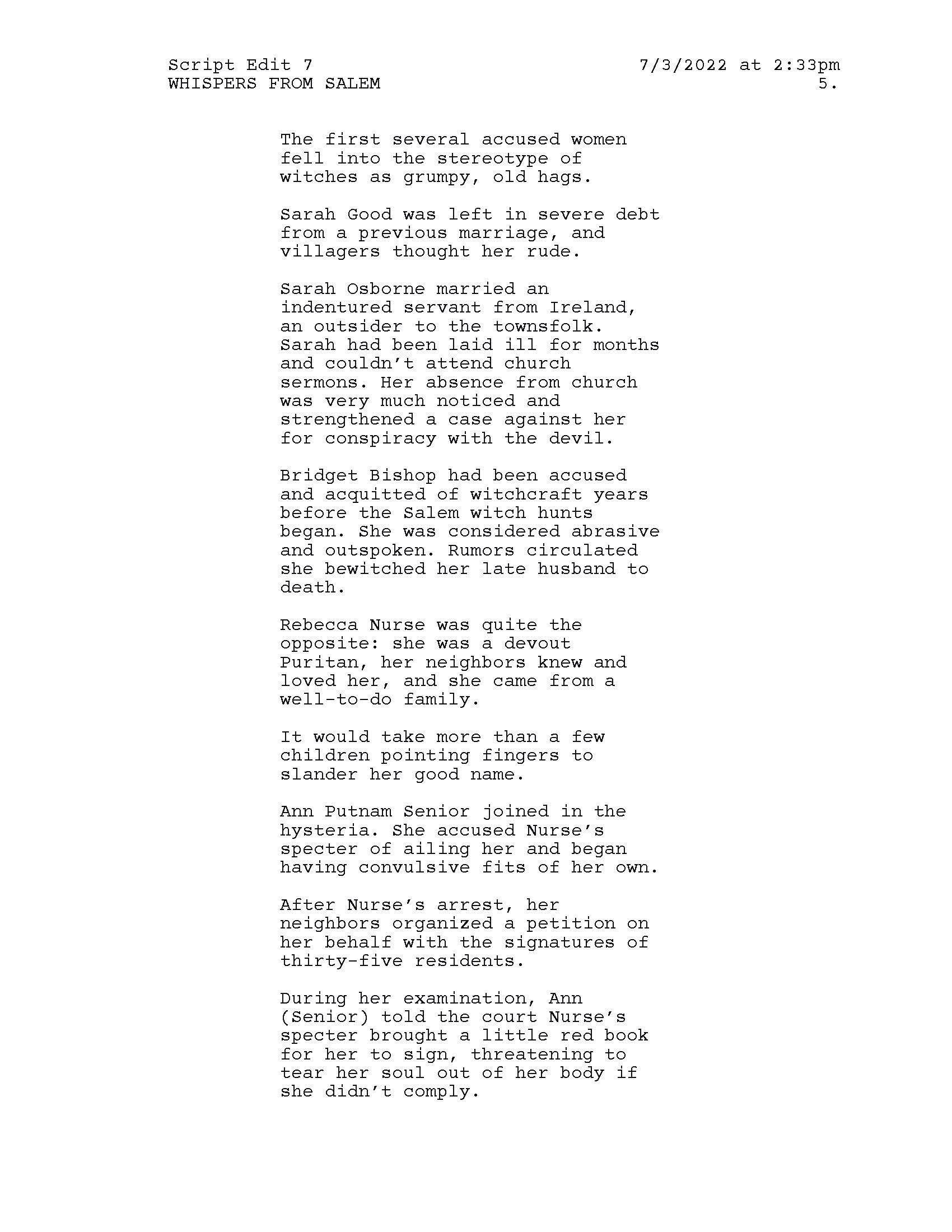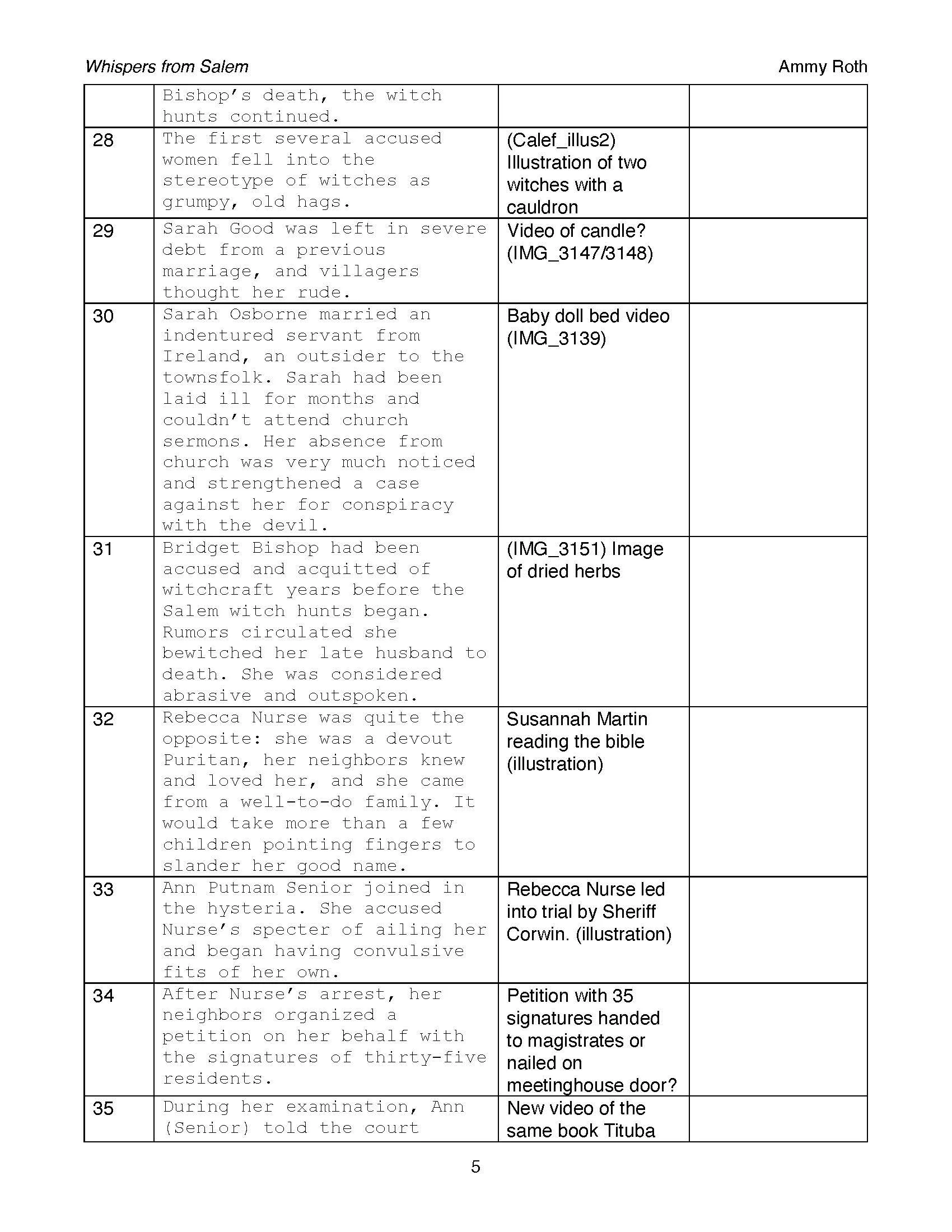
Whispers from Salem
Pre-Production and Planning
Historians and fanatics alike have grasped at straws searching for answers to the many questions surrounding the Salem Witch Trials, but every answer brings more questions. Although many records were destroyed or removed, there are several surviving documents from the court proceedings. In 1977, Paul Boyer and Stephen Nissenbaum published a volume of transcriptions of surviving documents from the trials, entitled The Salem Witchcraft Papers: Verbatim Transcriptions of the Court Records (now also available online).
I propose an examination of the “invisible” evidence that led to the arrests of more than two hundred residents of the Massachusetts Bay Colony in a mini-documentary, including gossip, rumors, family feuds, and apparitions. Salem Village was ripe with tiffs between powerful families and religious feuds, dividing the residents in the years preceding the trials. With this mini-documentary, I aim to dive deeper into the socio-economic and religious undertones of a community at war with itself and examine the complex relationships between the accused witches and their accusers.
How are the Salem Witch Trials relevant today? In the course of less than two full years, more than two hundred people were arrested, and twenty-five died for accusations of witchcraft through hearsay. Today, we continue to use “he said, she said” accounts and personal opinions to craft subjective beliefs about current events. To think a tragedy similar to the Salem Witch Trials is out of the realm of possibilities would be gravely ignorant. (Grave pun intended.)
Production
My goal for the rough script was not to write a perfect narrative. Instead, I word vomited the information I would use for each small section of the script. I used scripto to develop a professional script. Using the “Studio” template on scripto, I can also view the estimated air time it should take for the script to read aloud. The first draft was about eleven pages long, with nearly twenty minutes of reading time.
A twenty-minute documentary would likely be too long to complete in a few weeks, but I needed to edit the script anyway. So I printed a copy of my first draft from Scripto and began editing the dialogue with a pen. I focused more on creating a dialogue that sounds more natural than monotonous and robotic. I also wanted to condense the information as much as possible.
After editing the script to my satisfaction, I took a break from overthinking by searching for graphics online. Luckily, many illustrations depicted the events of the Salem Witch Trials. But unfortunately, most of these images were illustrated and published in the late 1800s, nearly two centuries after the witch trials. Nonetheless, these images describe the events well and provide a simple, pen-and-paper feel.
I printed out my finalized script and began marking potential graphics and sound effects. On the left side of the script, I only noted sound effects that would make the video more interesting. On the right side of the script, I included graphics and footage that would benefit the documentary.
Initially, I was going to create a traditional storyboard for this documentary. However, I chose to use a pre-production script to guide the recording of additional footage. I started with a table in Microsoft Word to create a pre-production script. The table includes Narration, Visuals, and Sound. Then, using the notes added to my script, I divvied up the script into sections on the pre-production table. Next, following the written notes on my printed script, I added potential graphics and sound effects to the table. I will continue to add graphics and sound effects throughout the filming process.






I made a shot list template for a previous project, so my headings include shot number, interior or exterior shot, location, camera angle, camera movement, audio recording, subject, and description. (I also include an act and scene number in the template for projects with acts and scenes.) Using my pre-production script from last week, I copied the sequences I needed to film into my shot list template. Then, I added shot numbers for each sequence and planned out other shot details, such as location, camera angle, and camera movement.
I also had a recording log template from a previous project, so I used the template for a new log. The recording log includes the edited file name, raw file, scene and take numbers, recording location, recording date, footage length, whether it will be used in the final video, and description. I filled out the information for the first two recordings.
I captured and edited footage of Annie Putnam pointing at the camera to seem unnerving. To do this, I added an exposure shift to brighten a video clip, followed by a darkened clip. Then, after a second of normal footage, I added a second brightened video clip.
I started recording audio sequences for the voiceover narration. However, my narration sounded monotonous, so I wanted to spice things up. First, I edited the script to avoid sounding like a history lecture. Next, I added a recording of Annie Putnam’s confession as the script’s main “story” element. I liked the idea of creating a bookend for the script with Annie’s confession, but it would overwhelmingly long to split in half. So instead, I separated it into multiple parts throughout the script.
After editing my script, I updated my pre-production script. I also changed the labeling for scene numbers. I set up a recording “studio” in the closet with a few pillows, sheets, and suitcases. The primary goal was to reduce the amount of echo in an empty closet as well as background noise from the house. Once I had the “studio” ready, I grabbed my water bottle, script, and Zoom H1n recorder.
Before recording this time, I practiced some vocal warm-ups (from Gary Terzza on YouTube) and did a quick word-vomit of the most important details I could remember about the Salem Witch Trials. This practice helped me get my vocal cords moving, work through difficult syllables, and (most importantly) made me start thinking specifically about the topic of my mini-documentary.
Post-Production
Since I’m creating a mini-documentary, research was one of the most important aspects of the project. Hefty research also means the video had so much information to offer. The voiceover narration was critical to telling the stories of the Salem Witch Trials, so I let the audio lead the edited video footage.
I started the week by editing Annie Putnam’s confession audio. Then, I clipped the confession audio with the already edited voiceovers. Next, I put all the audio together in a way that would provide rest between sections but would also tie the sequences together. Then, I grabbed some background music from Epidemic Sound and added music to the narration. Finally, I played with audio files in PremierePro until the sequences flowed together. The full audio ended at 8 minutes and 19 seconds, but the video didn’t have credits added yet. So I added closing music to the end of the audio to push the final video length to 9 minutes.
I started editing graphics and footage to match the audio. But, there were a few more video sequences to film, so I worked on building a few more props. I needed a feather quill pen, a little red book, and a written petition. I followed a YouTube tutorial for cutting out a feather quill pen with a chicken feather. I didn’t have a little red book but found a light brown novel and used it instead. To create the effect of the “Devil’s book,” I soaked paper from a sketchpad in old coffee. The dyed paper turned out almost the exact color of the brown book’s pages.
After Rebecca Nurse was arrested, her neighbors wrote and signed a petition on her behalf attesting to her innocence. I found this document in online archives, but the document was faded and nearly illegible. So, I used my calligraphy pen to rewrite the document’s contents on paper from a sketchpad. I also wrote Annie Putnam’s confession and used a recording for the video.
I needed to record Tituba signing the devil’s book and the magistrates opening Nurse’s petition. The last sequences I needed to film were mostly outdoors, which was rather trying in 106-degree heat. I captured b-roll footage of trees and grassy areas for the opening sequences. I also needed footage of feet dangling from a tree or gallows.
I was still on the fence about how to create the title sequence for the video, but handwritten letters felt like an omnipresent feature. So, I wrote the title Whispers from Salem using Adobe Illustrator and a Wacom tablet. Then, I transferred the file to Adobe AfterEffects. I used the mask path feature in AfterEffects to cover the handwriting and uncovered a portion of the title one frame at a time. This animation made the title look like it was actively being written on the screen.
Without further ado:










